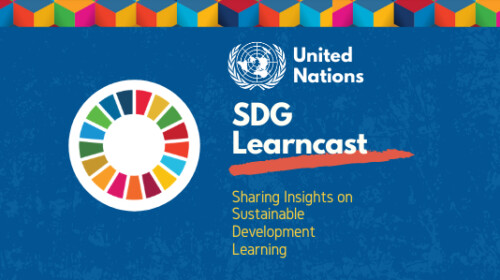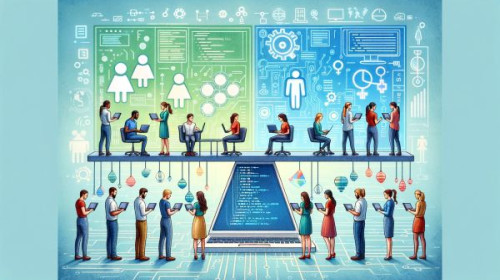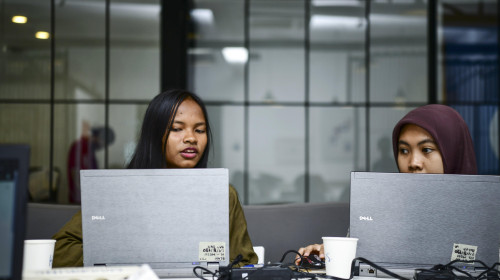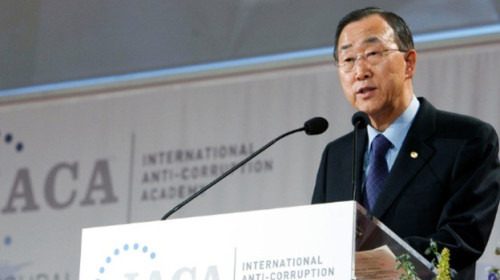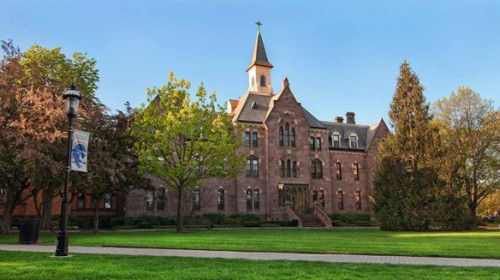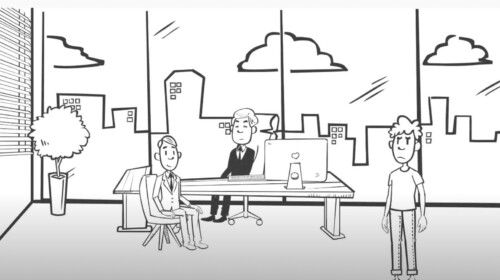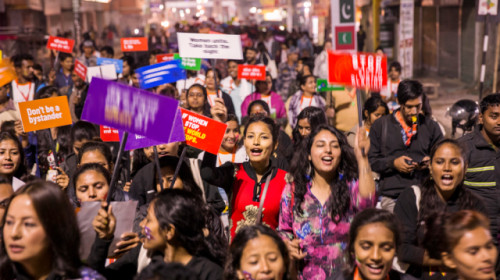In this podcast episode, we're joined by Yasmine Sherif, the Director of Education Cannot Wait (ECW), as she discussed the importance of quality education in crisis situations.
As a human rights lawyer with extensive field experience, Yasmine highlights the challenges of delivering education to the 222 million children lacking access today. Yasmine highlighted ECW's holistic approach to addressing this crisis, their hands-on experiences in places like Democratic Republic of Congo and Cox's Bazar, and the triumphs seen from strategic partnerships and programme investment, like in Colombia and Uganda.
She also talks about the role of technology in this field, painting a realistic picture of its limitations and possibilities.
Join us to discover how ECW advocates for education as the foundation of all sustainable development goals.
Want to learn more about sustainable development and learning? Subscribe to SDG Learncast on podcast apps.
[What follows is an edited transcription of the podcast, modified for enhanced web readability.]
Paulyn Duman: Welcome to the SDG Learncast with me, Paulyn Duman. In every episode, I bring insightful conversations around the subject of sustainable development and learning, helping us all to achieve a sustainable future. In this podcast episode, we welcome Yasmine Sherif, the Director of Education Cannot Wait, which is the United Nations Global Fund for Education in Emergencies and Protracted Crisis.
Yasmine will provide insights into the work of Education Cannot Wait, or ECW to support quality education outcomes for refugees, internally displaced and other crisis affected girls and boys, ensuring that no one is left behind.
Welcome to the SDG Learncast Yasmine!
Yasmine Sherif: Thank you, Paulyn. It's an honor to be here.
Paulyn Duman: Yasmine, could you tell us about your background and your work at ECW?
Yasmine Sherif: Absolutely, Paulyn. I am a human rights lawyer by training and started working with the United Nations in the late '80s. I have served in numerous crisis-affected areas worldwide, including Sudan, the Middle East, the Balkans, and Afghanistan. My background in both humanitarian and developmental work has been crucial for our work at ECW, as we need to bridge the gap between these sectors to provide SDG4 - quality education to children and adolescents affected by armed conflict, climate disasters, and forced displacement.
Paulyn Duman: Having witnessed numerous humanitarian crises, could you shed light on the unique challenges faced by education in such contexts and protracted crises?
Yasmine Sherif: Certainly. Most humanitarian contexts are not conducive to development, yet humanitarian assistance alone cannot empower individuals or create a foundation for a future free of crisis and conflict. This is where crisis-sensitive development steps in to facilitate empowerment beyond immediate humanitarian aid.
Education, encapsulated by SDG4, is a foundational development goal. To achieve objectives such as gender equality or the eradication of extreme poverty, it is essential to provide the young generation with quality education; otherwise, the Sustainable Development Goals (SDGs) will remain unattainable.
This is why the World Humanitarian Summit established Education Cannot Wait, to ensure more funding is directed towards education in emergencies and protracted crises. Since our operations began in 2017, we have grown into a large global fund with investments in over 44 crisis-affected countries.
Paulyn Duman: It's fascinating how ECW is making a difference in these humanitarian contexts and protracted crises. However, the consequences of neglecting education in humanitarian responses are often overlooked. What are the risks associated with not providing education to displaced children and youth?
Yasmine Sherif: Indeed, the figures concerning children and youth education in crisis-affected areas are alarming. Currently, 222 million children and youth lack access to quality education. This figure, obtained through meticulous research by ECW and endorsed by Civil Society and United Nations review panels, includes 78 million individuals who have never attended school.
Among these, 54% are girls, underlining the challenge of achieving gender equality, and 17% have functional difficulties. A further 16% are forcibly displaced. These figures indicate the gravity of the issue, especially for those in school but unable to learn due to inadequate teacher training, insufficient facilities, or lack of school supplies.
The absence of education exposes girls to threats such as sexual gender-based violence, trafficking, early marriages, and unwanted pregnancies. Boys, on the other hand, face the risk of being coerced into armed groups as child soldiers or terror groups. The school provides safety, protection, and hope for the future. However, it needs to offer quality education that incorporates mental health and psychosocial services, a school meal, and a pathway for learning, with a minimum of 12 years of education.
Paulyn Duman: It's crucial to address these barriers to education, particularly for marginalized children based on their backgrounds. Certain demographics, like girls and young people with disabilities, face even greater obstacles when it comes to education access. How does Education Cannot Wait strive to make education more accessible for these marginalized groups?
Yasmine Sherif: At Education Cannot Wait, we view education as a fundamental development service. However, implementing developmental solutions like education in a crisis-ridden country requires a deep understanding of the crisis context and dynamics. It's not possible to transpose strategies from countries with developmental challenges, like India, to countries in crisis like Afghanistan or Mali.
Our responses vary with the situation. In cases of sudden crisis escalation or refugee influx, we can provide swift, one-year financial support and a crisis-sensitive approach. However, our multi-year resilience programs, which bring humanitarian and development actors together in a joint program, are most notable.
This programme, a key part of the United Nations Secretary-General's Reform Program, combines resources from various sectors including teacher training, infrastructure, protection, water and sanitation, to form a holistic educational solution. By maintaining a strong focus on protection, especially for girls, boys, and educational facilities, we can design and implement these programs effectively in crisis-hit regions.
Paulyn Duman: We're delving into the holistic approach required to address education crises, which extends beyond simply providing educational resources. This approach necessitates considering factors like water sanitation and numerous interconnected elements that play into providing effective education. I'm genuinely intrigued by this holistic perspective that you apply at Education Cannot Wait. We'd appreciate a glimpse into how you navigate these intricacies, considering the numerous stakeholders, each with varying responsibilities, and the necessity for collaboration, coordination, and understanding the unique community needs in each context. Could you share with us your experience of working in such a situation? Your work goes beyond just education; there are people who need medical attention, food, water, and access to basic necessities. We're eager to learn how you juggle these multitude of pressing needs.
Yasmine Sherif: I'll give you a wonderful example that was really very moving, and I've seen so many of them as I travel around. I was recently in the Democratic Republic of Congo and we went to Tanzania, which is in Eastern DRC. We visited a village that had never seen a school before. And through this joint program - and there are many of those schools and efforts - we managed to create one. Everything we do is on a scale. It's not the single individual school here and there, but it's actually a scaled-up approach where we multiply it. You come to this school and the infrastructure is impeccable. There's a school there, all the washing facilities, the toilets are top-notch.
You can just imagine in a country where you don't have access to that, it's very difficult for a child to go to school. It's difficult for girls who are menstruating. It's difficult also in terms of feeling protected if you don't have bathrooms for girls and boys in a good quality and safe environment.
So we saw that as part of the school. The World Food Programme, the Salvation Army, and UNICEF had done a big part of that work. But then you also have World Food Programme, the Salvation Army, and local civil society. They provided school feeding. There was a big mental health and psychosocial services investment. The teachers had undergone proper quality training, and the school was under protection. You could feel very safe there as a child.
So, all the holistic elements were there, thanks to everyone working together. It wasn't like one organization comes in and provides school feeding in a school that doesn't have a bathroom, doesn't have infrastructure, no teacher training. That's a very fragmented way of doing it. But here, we could see a school that had all the facilities that you and I would've found when we went to school. That's how we operate, and it's possible because we bring in so many different actors with a variety of expertise and capacities.
It was fantastic to see that school. This is how we operate everywhere. We work with the Rohingya in Cox's Bazar, we make sure that every piece of the puzzle is matching for them. Of course, it's non-formal training because it's a political issue. We need to bring them, ideally, into the public school system like the one I met in the DRC or in Uganda.
But they also need political support. And of course, the government of Bangladesh will need financial support to absorb them into the public school system. But we do what we can through the non-formal system until the time comes, and we finally can help them into the public system or conditions have been conducive to their return, according to the standards set by UNHCR, to go back to Myanmar. But those conditions are not there yet.
Paulyn Duman: Your experiences truly inspire us, and it's easy to picture your team traversing diverse locations, grappling with potential personal safety risks. You're collaborating with various partners amidst vast community needs, even when things might not always run as smoothly as desired. It's truly heartening to realize that despite challenges, success is achievable, and there are dedicated individuals fervently working to ensure that children and young people caught in these situations aren't lost to this generation.
A recurring topic of discussion lately has been the role of technology in education, particularly in the context of humanitarian crises and prolonged conflicts. Would you be able to shed some light on this issue? How is technology utilized in delivering education in these challenging contexts? How accessible is it, and does it genuinely aid those you're trying to help?
Yasmine Sherif: Thank you very much. It's an important question because there's a lot of discussion about how we can harness technology, especially after Covid-19, when so many children and adolescents had to leave school. How can we consistently use technology to support ongoing learning?
It's important to remember that the majority of countries we invest in have a very weak or almost nonexistent infrastructure. While we can use technology in countries like Ukraine and its neighbors where necessary infrastructure is available, or in Lebanon, this is not possible in most of the countries we serve. Most of the 20 to 22 million children and adolescents cannot be reached with digital or broadcast distance learning. They don't have access to Wi-Fi or the necessary equipment, and the infrastructure in the country does not allow it. We're talking about children and adolescents in IDP camps in the desert. I visited Mali, and it was a vast desert with a few trees.
How do you introduce technology in Afghanistan, where 90% of the population lives in remote terrain? They lack basic infrastructure. We need to continue finding solutions, and one approach might be connecting these children to technology.
But we can't solely rely on technology, assuming the necessary infrastructure is in place. I recall a refugee family from Syria in Lebanon who had one smartphone shared between four children and two adults during Covid. The teachers were sending homework and tests via the smartphone. But there were four children in different grades and two adults. You don't have enough smartphones for the family to learn effectively. Plus, the refugee family must pay for the Wi-Fi, which could be up to $150 a month. No refugee family can afford this.
We need to put technology in its right context. If we rely only on technology, we forget about 95% of the 222 million children and adolescents who simply have no access or means.
I'd like to extend our appreciation and thanks to all the UN agencies and civil society organizations, both international and local, who live there and work tirelessly. They are our greatest heroes. Without them, we couldn't make these investments.
Our thanks go to them. We invest in them, and they do the actual work exceptionally well. They've allowed us to reach over 7 million children and adolescents with quality education. During Covid-19, about 31 million adolescents were reached through our investments. Our thanks also go to our colleagues in-country.
Paulyn Duman: Yasmine, could you share some success stories? Have children in humanitarian or protracted crises significantly benefited from gaining access to education? What insights or lessons have you learned from these successes?
Yasmine Sherif: Thank you. I also want to acknowledge the Ministry of Education, which leads the process with us, and appreciates and supports our work. In terms of success stories, I recently visited Colombia and met many refugees who have fled across the border from Venezuela. It was heartwarming to see our progress. When we began investing there, very little was in place for them. The government of Colombia absorbed 500,000 children from Venezuela into the public system. We supported this through non-formal learning and preparation for the public system.
I've also witnessed resilience in girls in eastern DRC. Out of the 200,000 girls who have been brutally raped, I met one who was able to attend school and learn after receiving support from our program. These experiences reinforce that every penny invested is worth it. We're making a difference and bringing hope.
Our goal is to reach 20 million children with our new strategic plan, for which we need $1.5 billion. We've secured about 60% of the resources two months into our strategic plan. However, I appeal to more strategic donor partners, governments, the private sector, and foundations to help us close the funding gap.
Paulyn Duman: Yasmine, the stories you've shared are inspiring. They show that with collective effort, hope can be restored. How can our listeners who want to contribute support education financing, particularly in humanitarian contexts and protracted crises?
Yasmine Sherif: Thank you for that question, Paulyn. Yes, you can help by advocating for education in emergencies and protracted crises. Advocate for those who are the furthest behind. Additionally, mobilize support and resources. We appreciate any action you can take to bring this to the attention of the world and those who can make a difference.
Paulyn Duman: Yasmine, thank you so much for your time and for sharing your story.
Yasmine Sherif: Thank you, Paulyn. It's been a pleasure and a privilege to be with you. Thank you so much. Goodbye.
Paulyn Duman: And that was Yasmine Sherif from Education Cannot Wait (ECW). In this episode, we discussed the challenges and needs in providing education in crisis-hit areas. She emphasized that humanitarian aid isn't enough on its own - we also need to bring development into these situations to truly empower people.
With around 222 million children and youth lacking quality education, ECW provides immediate, crisis-sensitive aid and develops multi-year programmes. Yasmine shares moving examples and their successes in helping children get access to education and basic needs.
However, she also cautioned us that technology isn't a cure-all solution, given the lack of infrastructure in many crisis areas. Yasmine ended with a call to action, encouraging listeners to advocate for education in these contexts, emphasizing that education is the foundation for sustainable development.
You can find more of the SDG Learncast on the UN SDG Learn website. For now, I’m Paulyn Duman. Thanks for listening.
Paulyn Duman is the Knowledge Management, Communications, and Reporting Officer at the United Nations System Staff College (UNSSC) Knowledge Centre for Sustainable Development and is a coordinator for the Joint Secretariat of UN SDG:Learn, together with UNITAR.
The opinions expressed in the SDG Learncast podcasts are solely those of the authors. They do not reflect the opinions or views of UN SDG:Learn, its Joint Secretariat, and partners.


